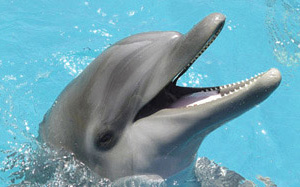 |
 |
 |
 Editorials | Environmental | May 2006 Editorials | Environmental | May 2006  
What's Dolphin for 'Flipper'?
 Keith Garvin - ABC News Keith Garvin - ABC News


| | Dolphins not only have a language - it includes names they use to address one another, according to marine biologists. Check out all of the local dolphins and learn their names at Vallarta-Adventures.com. |
We've always known dolphins were cute, lovable and smart. Now scientists say dolphins can communicate with one another by "whistling" their own names.

That's right. The mammals can recognize themselves and recognize and differentiate other members of the same species by using whistles, marine biologists say.

Researchers from Scotland's St Andrews University studied a school of bottlenose dolphins in Sarasota Bay, Fla., and found they use names rather than sound to identify one another. The three-year-study was funded by the Royal Society of London.

"We captured wild dolphins using nets when they came near the shore," said Vincent Janik, of the Sea Mammal Unit at St Andrews University. "Then in the shallow water we recorded their whistles before synthesizing them on a computer so that we had a computer voice of a dolphin."

"Then we played it back to the dolphins and we found they responded," he said. "This showed us that the dolphins know each other's signature whistle, instead of just the voice."

The research suggests that dolphins may be closer to humans than previously realized.

"I think it is a very exciting discovery because it means that these animals have evolved the same abilities as humans," Janik said. "Now we know they have labels for each other, like we do."

The findings are supported by other sources as well.

Denise Herzing, research director at the Wild Dolphin Project at Florida Atlantic University, said it was already clear that many of the 77 known cetacean (whale and dolphin) species had rudimentary languages.

"We know that dolphins' brains are nearly as large and complex, relative to body size, as those of humans," Herzing said. "They have evolved to be intelligent and that implies being able to communicate."

The research from the St. Andrews project has its origin in the 1960s, when dolphin trainers first noticed that captive animals each had their own personal repertoire of whistles. This prompted speculation that dolphins had their own language and might even have individual "names."

But dolphins may be just the first of many species in which individuals are found to have their own names.

Other researchers have already found evidence for highly developed language skills in parrots, crows and primates. Great apes, such as chimpanzees and orangutans, have been a popular subject for research because they are so closely related to humans.

The physical limitations of chimpanzees' vocal apparatus means they cannot speak, but researchers at Georgia State University have taught the primates to communicate in English through computers equipped with customized keyboards and voice synthesizers.

The African gray parrot is another renowned linguist, able not only to learn words but to use them in the right context. Even some rodent species may have developed a rudimentary language, researchers say. | 
 | |
 |



